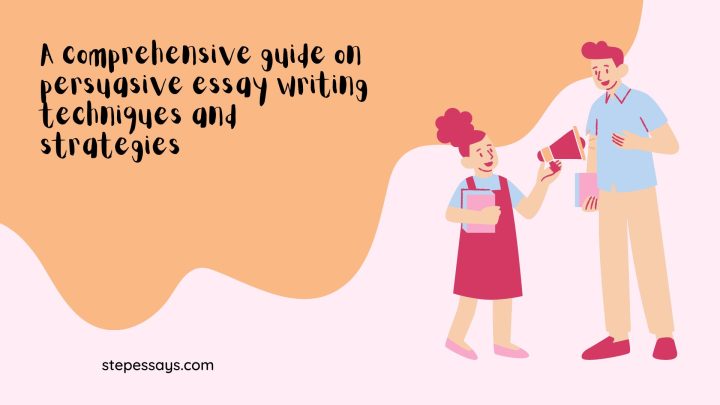Introduction
Persuasive writing is a powerful tool that allows individuals to influence others’ thoughts, beliefs, and actions. Whether you’re advocating for a cause, promoting a product, or arguing a point, mastering persuasive essay writing techniques is essential. In this comprehensive guide, we’ll look into various strategies and approaches to help you craft compelling persuasive essays that captivate your audience and drive them to action.

Writing strategies and techniques
Understanding Your Audience Writing techniques and strategies:
Understanding your audience is a fundamental technique for effective essay writing, serving as the cornerstone of persuasion. By looking into the demographics, interests, beliefs, and values of your audience, you can tailor your message to resonate deeply with their specific needs and preferences. Thorough research enables you to gain invaluable insights into their perspectives, allowing you to anticipate their reactions and craft arguments that speak directly to their concerns. Moreover, using language, tone, and examples that align with your audience’s worldview establishes an immediate connection, fostering trust and receptivity to your ideas. Ultimately, by empathizing with your audience and addressing their unique needs, you can maximize the persuasive impact of your essay and inspire meaningful action or change.
Establishing Credibility:
Crafting a Compelling Thesis Statement Writing techniques and strategies:
Structuring Your Essay Writing techniques and strategies:
Structuring your essay is a crucial aspect of mastering persuasive essay writing techniques and strategies. A well-organized essay follows a clear and logical structure that guides the reader through the argument effectively. Typically, it begins with an introduction that grabs the reader’s attention, provides context for the topic, and presents a compelling thesis statement. The body paragraphs then develop and support the thesis with evidence, examples, and logical reasoning, each paragraph focusing on a distinct aspect or argument. Transition sentences between paragraphs ensure smooth flow and coherence. Addressing potential counterarguments and refuting them strengthens the overall persuasiveness of the essay. Finally, the conclusion restates the thesis and summarizes the main points, leaving a lasting impression on the reader. By structuring your essay in this manner, you can effectively engage your audience and make a compelling case for your viewpoint.
Utilizing Persuasive Techniques:
Utilizing persuasive techniques is essential in mastering persuasive essay writing techniques and strategies. Effective persuasion involves employing a variety of rhetorical devices and appeals to engage the audience and convince them of the writer’s viewpoint. These techniques include ethos, pathos, and logos, which appeal to credibility, emotion, and logic, respectively. Ethos establishes the writer’s authority and trustworthiness on the subject, pathos evokes emotions to create a connection with the reader, and logos uses reasoning and evidence to build a logical argument. Additionally, employing rhetorical devices such as parallelism, repetition, and rhetorical questions can enhance the persuasiveness of the essay by making the argument more memorable and impactful. By strategically incorporating these persuasive techniques into their writing, writers can effectively sway their audience and achieve their persuasive goals.
Appealing to Emotions Writing techniques and strategies:
Providing Convincing Evidence:
Addressing Counterarguments:
Addressing counterarguments is a fundamental aspect of persuasive essay writing techniques and strategies, as it demonstrates the writer’s thorough consideration of opposing viewpoints and strengthens their credibility. Acknowledging and refuting potential counterarguments not only anticipates objections from the audience but also shows respect for differing perspectives. By addressing counterarguments directly, writers can preemptively dismantle opposing views and bolster the persuasiveness of their own arguments. This can be achieved through careful analysis, presenting evidence to rebut opposing claims, and demonstrating why the writer’s perspective remains the most valid and compelling. Furthermore, addressing counterarguments in a persuasive essay demonstrates intellectual honesty and integrity, as it shows a willingness to engage with alternative viewpoints rather than simply dismissing them. Ultimately, effectively addressing counterarguments strengthens the overall persuasiveness of the essay by demonstrating the writer’s ability to engage critically with the topic and provide a well-rounded argument.
Engaging with the Reader:
Engaging with the reader is a vital aspect of mastering persuasive essay writing techniques and strategies, as it fosters a connection that enhances the impact of the writer’s arguments. Effective engagement involves capturing the reader’s interest from the outset through compelling introductions, provocative questions, or vivid anecdotes that draw them into the topic. Throughout the essay, writers can maintain engagement by using inclusive language, addressing the reader directly, and inviting them to reflect on the issues presented. Furthermore, incorporating rhetorical devices such as imagery, humor, or rhetorical questions can create a dynamic and interactive reading experience. By engaging with the reader on an emotional and intellectual level, writers can cultivate empathy, curiosity, and receptiveness to their persuasive message, ultimately increasing the likelihood of persuading the audience to adopt their viewpoint.
Concluding Effectively:
Conclusion:
Mastering persuasive essay writing techniques requires a combination of skill, strategy, and creativity. By understanding your audience, establishing credibility, crafting compelling arguments, and engaging with readers effectively, you can create persuasive essays that inspire action and drive change. Whether you’re advocating for a cause, influencing opinions, or promoting a product, the power of persuasion lies in your ability to connect with your audience and compel them to embrace your viewpoint. With these techniques and strategies at your disposal, you’re equipped to become a persuasive writing maestro, capable of influencing hearts and minds through the written word.
